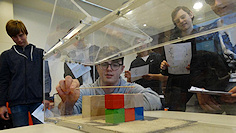|
|
|
Close Help | ||||||||||||||
Přijďte k nám ve dnech 12., 14. a 16. listopadu 2019, ať vidíte, na čem děláme! Více zde.

First principles or ab initio means to perform the calculations of the properties of a system from fundamental quantum mechanics with no parametrization or knowledge of experimental data. The Density Functional Theory (DFT) forms the basis for most of current first-principles methods and it is able to provide the exact information about the electronic structure of the system under study and subsequently about its internal energy. Nowadays, employing DFT for calculations of elastic properties is routine task for system with ideal crystal lattices. On the other hand, estimation of elastic properties is still challenging for systems with chemical disorder or with defect in crystal lattice despite large computational resources available to the scientific community. The recently introduced stress-strain method together with the DFT package VASP is able to provide the full matrix of elastic constants with reasonable computational cost also for large supercells describing lattices with defects, e.g. grain boundaries or twin boundaries. Large supercells are also required for description of alloys with chemical disorder by the supercell-based quasirandom structures (SQS). Further directional optimization of SQS (do-SQS) supercell is necessary to obtain proper matrix of elastic constants that will reflect the symmetry of the simple ordered lattice. Using of the stress-strain method and do-SQS approach will be demonstrated for Ni3Si and Ni3Al intermetallics, CoCrNi high entropy alloy and Ni2MnGa magnetic shape memory alloy.